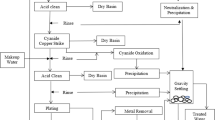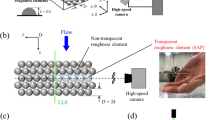Abstract
Experimental and modelling investigations of the hydrodynamics of the internal flow structure in the circulating particulate bed electrode (CPBE) are reported. The CPBE, a hybrid between an expanded packed bed and an entrained/fluidized bed, is particularly well suited for many electrochemical applications such as metal recovery and pollution treatments for metal containing effluents. This study deals with the fundamental hydrodynamics and particle dynamics of the CPBE. A mathematical model of the CPBE has been developed which successfully describes the motion of the particles and the fluid in the bed. It is shown that many of the flow characteristics of the circulating bed can be predicted using fundamental data. The validity of the proposed model was demonstrated by comparing predictions to experimental observations of several bed characteristics under various operating conditions.
Similar content being viewed by others
Abbreviations
- A :
-
cross-sectional area of the cell (m2)
- d p :
-
mean particle diameter (m)
- C D :
-
experimentally determined constant calculated by Haider and Levenspiel [26]
- C :
-
proportional constant in Equation 15
- CR :
-
circulation rate of solids (m3 s−1)
- D :
-
hydraulic diameter of the vessel (m)
- g :
-
gravitational constant (kg m s−2)
- G :
-
flow rate (kg s−1)
- H D :
-
height of the particles inside the descending layer (m)
- H R :
-
height of the particles inside the rising layer (m)
- L :
-
length (m)
- n :
-
Richardson and Zaki index (−)
- ΔP :
-
pressure drop (N m−2)
- Q :
-
inlet liquid flow rate (m3 s−1)
- R :
-
reaction force between the descending layer and the cell wall (kg m-¨)
- T :
-
total bed thickness (m)
- t D :
-
descending layer thickness
- t R :
-
rising layer thickness tan θ coefficient of friction (−)
- U l :
-
superficial liquid velocity (m s−1)
- U i :
-
a function of terminal velocity (equation 3) (m s−1)
- U t :
-
particle terminal velocity (m s−1)
- V :
-
interstitial velocity or actual velocity (m s−1)
- V 1 :
-
slip velocity in the rising layer (m s−1)
- V 2 :
-
slip velocity in the descending layer (m s−1)
- W :
-
width of the bed (m)
- ε:
-
bed voidage (the fraction of the total volume which is made up of the free space between the particles and is filled with fluid) (−)
- εI :
-
packed bed voidage before bed expansion (−)
- θ:
-
tilt angle (radians or degrees)
- ϱs :
-
solid density (kg m−3)
- ϱf :
-
fluid density (kg m−3)
- µfPf:
-
solution viscosity (kg m s−1)
- θs :
-
particle sphericity (−) Subscripts
- D:
-
descending layer
- L(f):
-
liquid (fluid) component
- R:
-
rising layer
- S:
-
solid component
- L:
-
liquid component
- T:
-
total depth of the bed
- P:
-
particles
- t:
-
terminal
References
K. B. Mathur and N. Epstein, ‘Spouted Beds’, Academic Press, New York (1974).
F. Goodridge, C. J. King and A. R. Wright, Electrochim. Acta 22 (1977) 1087.
J. R. Backhurst, J. M. Coulson, F. Goodridge and R. E. Plimley, J. Electrochem. Soc. 116 (1969) 1600.
F. Coeuret, J. Appl. Electrochem. 10 (1980) 687.
H. D. Steppke and R. Kammel, Erzmetall. Bd., ‘Electrolysis with Fluidized Bed Electrodes’, 26 H11 (1973) 533.
G. S. James, B. I. Dewar and W. R. Moergeli, US Patent 3981787 (1976).
G. S. James, B. I. Dewar and W. R. Moergeli, US Patent 3945892 (1976).
A. F. R. Newton, US Patent 4065375 (1977).
J. A. E. Wilkinson, R. S. H. Leslie, D. M. Glindon, K. P. Haines and K. Baker, US Patent 4035278 (1977).
R. Kammel and H. W. Lieber, Galvanotechnik 69 (1978) 687.
F. Goodridge, Electrochim. Acta 22 (1977) 929.
F. Goodridge and C. J. Vance, Electrochim. Acta 22 (1977) 1073.
K. Scott, J. Appl. Electrochem. 18 (1988) 504.
K. Nakamura and C. E. Capes, Can. J. Chem. Eng. 51 (1973) 39.
S. Morooka, K. Kawazuishi and Y. Yayo, Powder Tech. 26 (1980) 75.
S. Morooka and K. Leschonski, J. Chem. Eng. 36 (1987) 59.
F. Berruti and N. Kalogerakis, Can. J. Chem. Eng. 67 (1989) 1010.
M. J. Rhodes, Power Technol. 60 (1990) 27.
H. Arastoopour and D. Gidapow, Ind. Eng. Chem. Fund. 18 (1979) 123.
Y. Li and M. Kwauk, in ‘Fluidization’ (edited by J. R. Grace and J. M. Matsen), Plenum Press, New York (1980), p. 537.
B. Dinrong, J. Yong and Y. Zhiqing, in ‘Fluidization’ (edited by M. Kwauk and D. Kunii), Science Press, Beijing, China (1988), p. 155.
M. Horio, K. Morishita, O. Tachibana and N. Murata, in ‘Circulating Fluidized Bed Technology II’, (edited by P. Basu and J. F. Large), Pergamon Press, Toronto (1988), p. 147.
H. Ishii, T. Nakajima and M. Horio, Jap. J. Chem. Eng. 22(5) (1989) 484.
M. Horio and Y. Takei, in Proceedings of the 3rd International Conference on Circulating Fluidized Beds, 15 Oct., Nagoya, Japan (1990).
H. Zhang, Y. Xie, Y. Chen and M. Hasatani, inProceedings of the 3rd Conference on Circulating Fluidized Beds, 15 Oct., Nagoya, Japan (1990).
D. Kunii and O. Kevenspiel, ‘Fluidization Engineering’, 2nd edn, J. Wiley & Sons, New York (1991).
W. K. Lewis, E. R. Gilliland and W. C. Bauer, Ind. Eng. Chem. 41 (1949) 1104.
A. Richardson and W. N. Zaki, Trans. Inst. Chem. Eng. 32 (1954).
G. B. Wallis, ‘One Dimensional Two Phase Flow’, McGrawHill, New York (1967).
V. D. Stankovic, G. Lazarevic and A. A. Wragg, J. Appl. Electrochem. 25 (1995) 864.
S. Ergun, Chem. Eng. Progr. 48 (1952) 89.
N. Epstein, Ind. Eng. Chem. Process. 7 (1968) 158.
J. M. Matsen, Ind. Eng. Chem. 7 (1969) 159.
B. M. Dweik, MSc thesis, Case Western Reserve University, May (1995).
Author information
Authors and Affiliations
Rights and permissions
About this article
Cite this article
Dweik, B.M., Liu, C.C. & Savinell, R.F. Hydrodynamic modelling of the liquid-solid behaviour of the circulating particulate bed electrode. J Appl Electrochem 26, 1093–1102 (1996). https://doi.org/10.1007/BF00243733
Received:
Revised:
Issue Date:
DOI: https://doi.org/10.1007/BF00243733




